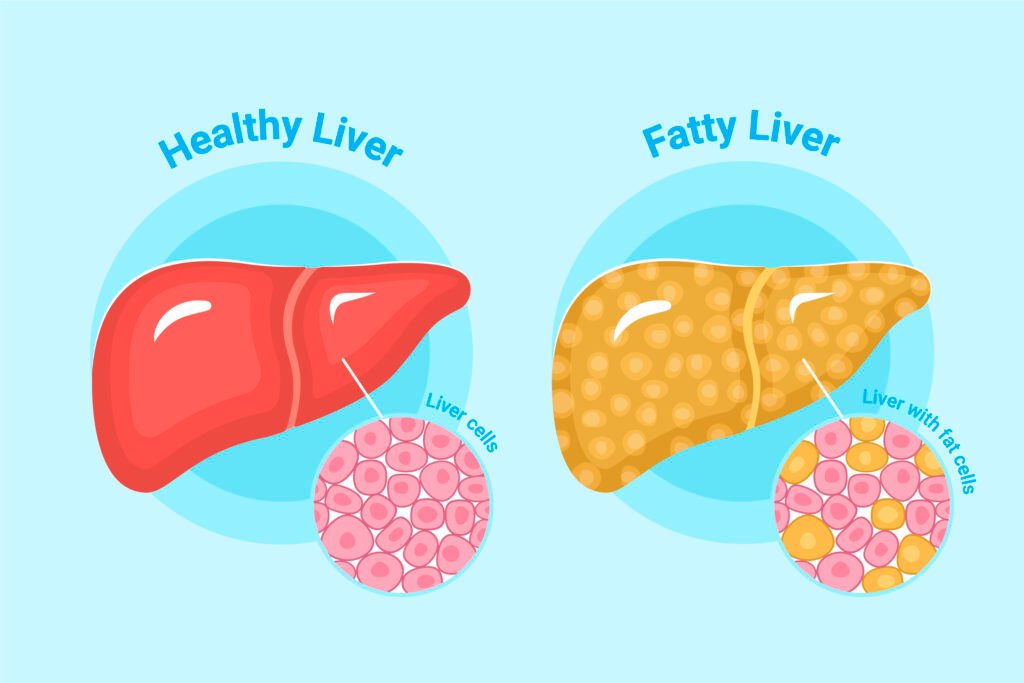
The liver is one of the most hardworking organs in the body, responsible for processing nutrients, storing energy, and detoxifying harmful substances. However, when excess fat begins to build up in the liver, it can lead to fatty liver disease—a growing health concern worldwide.
What makes fatty liver especially dangerous is that it often develops silently, without obvious symptoms, until serious damage has occurred. In this article, we’ll explore what fatty liver is, the different stages of the disease, common fatty liver symptoms, and the most important diet tips to reverse it.
What Is Fatty Liver?
Fatty liver occurs when fat droplets accumulate in liver cells. A healthy liver is dark red and smooth, but when fat builds up, it becomes enlarged and less efficient.
There are two main types:
Alcoholic fatty liver disease (AFLD): Caused by heavy alcohol use.
Non-alcoholic fatty liver disease (NAFLD): Caused mainly by excess sugar, especially fructose.
Both forms follow a similar progression:
Simple fatty liver (steatosis): Fat is present but with little or no inflammation.
NASH (Non-Alcoholic Steatohepatitis): Inflammation and liver cell damage occur, increasing risk of scarring.
Cirrhosis: Severe scarring stiffens the liver, making it difficult to function. At this stage, a liver transplant may be the only option.
According to the Mayo Clinic, fatty liver disease is becoming increasingly common and can affect people who drink little or no alcohol.
Fatty Liver Symptoms
One of the challenges with fatty liver disease is that early stages often have no clear symptoms. Many people don’t realize they have it until advanced damage has occurred.
Some possible signs and risk indicators include:
Elevated liver enzymes (ALT) on blood tests.
Fatigue and low energy.
Discomfort or pain in the upper right abdomen.
Unexplained weight gain or difficulty losing weight.
However, the most reliable way to detect fatty liver is through medical tests such as imaging scans or bloodwork.
Risk Factors for Fatty Liver
Several factors increase the likelihood of developing fatty liver:
Insulin resistance (strongest predictor of NAFLD).
Obesity or high BMI.
High cholesterol and triglycerides.
Excessive alcohol consumption.
Poor diet high in sugar and processed foods.
Even lean individuals can develop fatty liver if they are insulin resistant.
Diet Tips to Reverse Fatty Liver
The good news is that fatty liver—especially in its early stages—is reversible. The liver is a resilient organ that can heal if fat accumulation is reduced.
1. Cut Down on Sugar and Fructose
Sugar (especially liquid sugars like soda, juice, and sweetened coffee drinks) is one of the biggest contributors to fatty liver. Even natural sweeteners such as honey or agave are high in fructose and should be limited.
2. Limit Alcohol Intake
Alcohol significantly accelerates liver fat buildup and inflammation. Reducing or eliminating alcohol is crucial in reversing fatty liver disease.
3. Focus on Whole, Nutrient-Dense Foods
Replace processed foods with:
Lean proteins (chicken, fish, legumes).
Fresh vegetables and fruits (in moderation).
Whole grains and fiber-rich foods.
Healthy fats (avocado, olive oil, nuts).
4. Lose Excess Weight
Weight loss, even as little as 5–10% of body weight, can significantly reduce fat in the liver and improve liver function.
The NHS recommends reducing sugar, avoiding alcohol, and maintaining a healthy weight to help reverse fatty liver disease naturally.
Conclusion
Fatty liver is becoming increasingly common, affecting nearly 25% of the global population. Since fatty liver symptoms are often silent, many people are unaware they have the condition until serious damage occurs.
The key to reversing fatty liver disease lies in diet and lifestyle: cutting down on sugar and alcohol, eating whole foods, and maintaining a healthy weight. By making these changes early, you can restore your liver health and prevent complications such as cirrhosis, diabetes, and heart disease.
Your liver is resilient—give it the right environment, and it can heal.